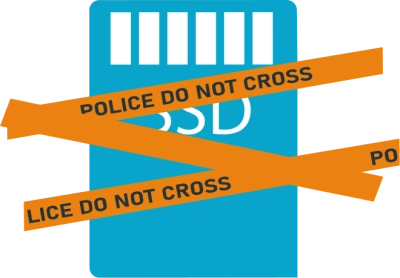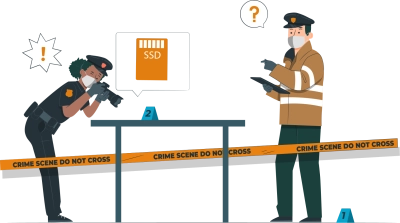Forensic RAID Recovery
In the realm of digital forensics, the recovery of data from RAID (Redundant Array of Independent Disks) configurations presents a unique and challenging task. Forensic RAID Recovery is a critical process used in investigations where data retrieval from damaged or compromised RAID arrays is essential.
This article delves into the complexities of RAID systems, the importance of RAID recovery in forensic investigations, and the sophisticated methods employed by experts to extract, reconstruct, and analyze data from various RAID configurations.
From understanding RAID fundamentals to exploring advanced recovery techniques, we provide a comprehensive guide to the art and science of forensic RAID recovery, making it an invaluable resource for IT professionals, forensic analysts, and anyone interested in the intersection of technology and law enforcement.
What is the forensic data recovery process?

Forensic data recovery is a meticulous process used in digital forensics to retrieve data from digital storage devices that may be damaged, corrupted, or intentionally manipulated. The goal is to extract and preserve digital evidence in a manner that maintains its integrity and allows it to be admissible in legal proceedings. Here's an overview of the typical steps involved in the forensic data recovery process:
- Identification: This initial step involves identifying the relevant data sources. These can include hard drives, SSDs, mobile devices, cloud storage, or any other digital storage mediums.
- Preservation: Once the data sources are identified, the next step is to ensure that the data is preserved in its current state. This often involves creating a bit-by-bit copy (or image) of the storage device. Tools like write blockers are used to prevent any alterations to the original data.
- Acquisition: This step involves capturing the data from the device. Data acquisition must be done in a way that avoids altering the data. This is typically achieved through forensic imaging, which creates an exact sector-by-sector copy of the storage medium.
- Analysis: During analysis, forensic experts use various tools and techniques to examine the recovered data. This can include recovering deleted files, decrypting encrypted files, and analyzing file structures and remnants of data to piece together what happened.
- Documentation and Reporting: Every action taken during the recovery process is documented in detail. This includes how the evidence was discovered, how it was preserved, and the methods used in the recovery process. The findings are then compiled into a report which is often used in legal settings.
- Presentation: In some cases, forensic experts may be required to present their findings in court. This involves explaining the technical process in a manner that is understandable to the layperson and defending their methods and findings under cross-examination.
- Disposition: After the case is closed, the data must be handled according to legal requirements and organizational policies. This may involve securely storing the data for a certain period or permanently destroying it.
The forensic data recovery process is guided by the principles of maintaining the authenticity, reliability, and integrity of the data. It's essential that the process is conducted in a manner that is legally compliant and methodologically sound to ensure the data can be used as reliable evidence in legal proceedings.
Forensic RAID data recovery - How it works

Forensic RAID data recovery is a specialized process used in digital forensics to recover data from RAID (Redundant Array of Independent Disks) systems. RAID systems are commonly used in enterprise environments for data redundancy and performance improvement. The forensic recovery of data from RAID arrays is a complex task due to the unique way in which data is distributed and stored across multiple disks. Here's an overview of how forensic RAID data recovery works:
Understanding RAID Configurations
First, it's essential to understand the specific RAID configuration (e.g., RAID 0, RAID 1, RAID 5, RAID 6, etc.), as each type has a different method of data storage and redundancy. This influences the approach to data recovery.
1. Identification and Preservation
- Identify RAID Level: The forensic team identifies the RAID level and the number of drives in the array.
- Preserve Original Drives: The drives are carefully handled to avoid further data loss. Forensic imaging/cloning of each drive in the RAID array is done to preserve the original state.
2. Acquisition
- Imaging: Each drive is imaged separately. This step creates exact bit-by-bit copies of each drive, ensuring that the original data remains unaltered.
- Reconstruct RAID Array: Using specialized software, forensic experts virtually reconstruct the RAID array using the images of the individual drives. This step is crucial as it requires an understanding of the RAID algorithm and parameters.
3. Analysis
- Data Recovery: Tools are used to recover data from the reconstructed RAID array. This may include retrieving deleted files, extracting latent data, and piecing together fragmented data.
- File System Analysis: The file system (NTFS, FAT, ext, etc.) is analyzed to recover file structures and metadata.
4. Documentation and Reporting
- Detailed Documentation: Every step of the recovery process is documented in detail. This includes the methods used to reconstruct the RAID array and the data recovery techniques employed.
- Reporting: A comprehensive report is prepared that outlines the findings, the process used for recovery, and any challenges encountered during the process.
5. Legal Admissibility
- Chain of Custody: Maintaining a clear chain of custody is crucial to ensure the admissibility of the recovered data in legal proceedings.
- Integrity and Authenticity: The integrity and authenticity of the data are preserved throughout the process, ensuring that it remains reliable and court-admissible.
Special Considerations
- Encryption: If the RAID drives are encrypted, additional steps are required to decrypt the data.
- Damaged Drives: In cases of physically damaged drives, special hardware and techniques are required to recover the data.
- RAID Controller Metadata: Sometimes, metadata stored on the RAID controller is crucial for reconstruction.
Forensic RAID data recovery requires a blend of technical expertise in RAID architectures, experience with various file systems, and a meticulous approach to ensure the integrity of the recovered data. The complexity of the process can vary greatly depending on the RAID level, the condition of the drives, and the specifics of the case.
How do I recover from RAID failure?

Recovering from a RAID failure can be a challenging task, depending on the RAID level, the nature of the failure, and whether you have a recent backup. The process typically involves several steps, focusing on minimizing data loss and restoring system functionality. Here's a general guide on how to recover from RAID failure:
1. Assess the Situation
- Identify RAID Level: Determine the RAID level (e.g., RAID 0, RAID 1, RAID 5, etc.) as recovery steps differ for each.
- Diagnose the Failure: Determine whether the failure is due to hardware (disk failure) or software (corruption, controller issues).
2. Backup Data (If Possible)
- If the RAID array is still partially accessible, attempt to back up important data immediately.
- Do not write new data to the RAID array, as this can overwrite recoverable data.
3. Check for Physical Damage
- Inspect the drives for physical damage.
- If a drive is physically damaged (e.g., making unusual noises), turn off the system immediately to prevent further damage and consider professional recovery services.
4. Replace Faulty Hardware
- If a specific drive has failed, replace it with a new one of the same size and speed.
- If the failure is due to a RAID controller or other hardware component, replace it carefully.
5. Rebuild the RAID Array
- Most RAID levels (except RAID 0) support rebuilding the array with the replacement of a failed drive.
- Initiate the rebuild process either through the RAID controller's software or BIOS settings.
6. Data Recovery Software
- If the RAID array cannot be rebuilt or if data is still missing after a rebuild, consider using DiskInternals RAID Recovery software.
- Select software compatible with your RAID level and file system.
- These tools can help reconstruct RAID parameters and recover data.
7. Monitor the Rebuild Process
- RAID rebuilds can take a long time, especially for large arrays. Monitor the process to ensure it completes successfully.
8. Verify Data Integrity
- Once the rebuild is complete, check the data integrity.
- Ensure that important files and applications are functioning correctly.
9. Implement Preventive Measures
- Regularly back up your data to avoid data loss in future failures.
- Consider implementing a more fault-tolerant RAID level if applicable.
Important Considerations
- RAID 0: If you're using RAID 0 and a drive fails, data recovery becomes more complex, as RAID 0 offers no redundancy.
- Time-Sensitive Data: If the data is critical and time-sensitive, it’s often best to go straight to professional recovery services.
Remember, the specific steps and their feasibility can vary greatly depending on the RAID configuration and the nature of the failure. Always prioritize the safety and integrity of your data.
How to recover data from RAID using DiskInternals RAID Recovery
Recovering data from a RAID array using DiskInternals RAID Recovery involves a series of steps. DiskInternals RAID Recovery is designed to reconstruct RAID arrays and recover data from them. Here's a general guide on how to use this software for RAID data recovery:
Pre-Recovery Preparations
1. Download and Install DiskInternals RAID Recovery: Ensure you have the latest version of the software. It's available on the DiskInternals website.
2. Prepare Your Computer: If possible, it's advisable to perform the recovery process on a computer other than the one where the RAID failure occurred, to avoid potential overwriting of data.
3. Connect the RAID Drives: Connect the RAID drives to the computer where you will perform the recovery. If using an external dock or enclosure, ensure all drives are correctly connected and recognized by the system.
Data Recovery Process
1. Launch DiskInternals RAID Recovery: Open the software on your computer.
2. Select the RAID Type: The software should recognize the RAID type automatically. If not, manually select the RAID type (e.g., RAID 0, RAID 1, RAID 5, etc.) that matches your configuration.
3. Automatic or Manual Mode:
- Automatic Mode: This mode is suitable for users who are not sure about the RAID parameters. The software will attempt to detect and reconstruct the RAID array automatically.
- Manual Mode: Choose this mode if you know the exact parameters of your RAID configuration. You'll need to input parameters like the order of disks, stripe size, etc.
4. Scan for Data: Once the RAID configuration is identified or set, start the scanning process. This process can take some time, depending on the size of the drives and the extent of the damage.
5. Preview Recoverable Files: After the scan, DiskInternals RAID Recovery will display a list of recoverable files. You can preview these files before recovery to ensure they are the ones you need.
6. Select and Recover Files: Choose the files or directories you want to recover. Select a safe location to save the recovered data – preferably on a different drive than the RAID array to avoid data overwriting.
7. Save Recovered Data: Once you've selected the files, proceed with the recovery. The software will save the recovered files to the location you specified.
Post-Recovery
- Verify Recovered Data: Check the recovered data for integrity and completeness.
- Backup: It's a good practice to back up your data regularly to prevent future data loss.
Important Tips
- Trial Version: DiskInternals RAID Recovery offers a trial version. Use this to see if your data can be recovered before purchasing the full version.
- Avoid Data Overwrite: Do not install the software on the drive where data loss occurred, and do not recover files to the same drive.
- Professional Help: If the data is extremely important or if the recovery process is not yielding results, consider seeking professional data recovery services.
Remember, the success of the recovery process can depend on the extent of the RAID failure and the condition of the drives. If the drives are physically damaged, software-based recovery might not be sufficient.
